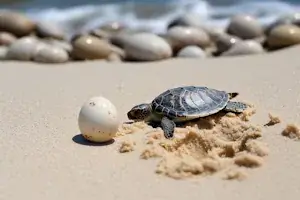Hatching and Incubating Turtle Eggs: A Comprehensive Guide
Turtles are among the most fascinating reptiles kept as pets worldwide. However, breeding turtles is not only exciting but also requires patience and care. The hatching of the eggs is a crucial step that significantly influences the success of breeding. In this article, you will learn everything you need to know about hatching and incubating turtle eggs.
1. Basics: What You Should Know Before Breeding
Before you start incubating turtle eggs, it’s important to understand a few basic concepts:
- Species-Specific Requirements: Different turtle species have different breeding and incubation needs. Make sure to thoroughly research the requirements of the species you are keeping.
- Sex Determination: In turtles, the gender of the offspring is influenced by the incubation temperature. Lower temperatures often result in males, while higher temperatures produce females.
- A healthy, sexually mature turtle pair and optimal living conditions are essential for successful mating and egg-laying.
2. Preparing the Egg-Laying Area
Female turtles need a suitable place to lay their eggs. In captivity, a terrarium or an outdoor enclosure should be equipped with an egg-laying area.
- Substrate: A mixture of moist sand and soil works well. The substrate should be at least 20 cm deep to allow the turtle to safely bury her eggs.
- Moisture: The substrate should be moist but not soaked. This helps with digging and maintains a stable temperature and humidity.
- Peace and Quiet: Ensure that the turtle is not disturbed during egg-laying, as stress can cause her to hold the eggs back.
Once the eggs are laid, carefully dig them up and transfer them to the incubator.
3. Collecting the Turtle Eggs
When collecting the eggs, it’s important to exercise caution. Do not rotate or tilt the eggs, as the embryos are attached to the inner membrane, and any misalignment could disrupt their development.
- Marking: Use a soft pencil to mark the top of the eggs to ensure they are not rotated during the transfer to the incubator.
- Transport: Use a small container with moist substrate to safely transport the eggs.
4. The Incubator: Setup and Configuration
An incubator is a crucial tool for successful incubation of turtle eggs. You can either use a commercial incubator or build your own.
- Temperature: The optimal temperature depends on the species but typically ranges between 26°C and 32°C. Use a reliable thermometer to check the temperature regularly.
- Humidity: The humidity should be between 70% and 90%. A hygrometer helps you monitor the humidity levels.
- Ventilation: Proper air circulation is important to prevent mold growth. Ensure the incubator is ventilated.
Substrate in the Incubator:
A mix of vermiculite and water in a 1:1 ratio (by weight) is commonly used. Gently press the eggs into the substrate so that about half of the egg is visible.
5. Temperature and Sex Determination
As mentioned, the temperature of the incubation process affects the gender of the turtles:
- Lower temperatures (26–28°C): Promote the development of males.
- Higher temperatures (30–32°C): Promote the development of females.
- Intermediate temperatures: Can result in a mixed gender distribution.
A constant temperature is crucial. Fluctuations can negatively affect embryo development.
6. Monitoring the Incubation
During the incubation period, which can last between 50 and 120 days, regularly check the conditions in the incubator.
- Temperature Control: Fluctuations can be minimized with a backup power supply or thermostat.
- Humidity Monitoring: If the substrate dries out, you can carefully add distilled water. Be careful not to wet the eggs.
- Mold Check: If mold appears on the eggs, gently remove it using a cotton swab and a mild potassium permanganate solution.
7. The Hatching Process
The baby turtles will begin to make small cracks in the eggshell about 1–2 days before hatching. This process is known as “pipping.”
- Patience: The turtles will need time to free themselves from the egg. Avoid disturbing them during this process.
- Moist Environment: Keep the humidity in the incubator high to assist with the hatching.
- Once the baby turtles have hatched, they should remain in the incubator for a few hours to recover.
8. Caring for Newly Hatched Turtles
After hatching, the baby turtles require special care:
- Terrarium: A separate nursery tank with similar conditions to the parents’ environment (temperature, humidity, UV light).
- Food: Start with small amounts of soft food, such as finely chopped herbs or lettuce.
- Water: Ensure that the turtles have access to fresh water at all times.
Make sure the terrarium is safe, as the babies are especially sensitive to environmental factors.
9. Common Problems and Solutions
- Infertile Eggs: Some eggs may not develop because they are infertile. These should be carefully removed to avoid mold growth.
- Temperature Fluctuations: These can be prevented with a high-quality thermostat.
- Humidity Issues: If the substrate dries out, it can hinder the growth of the embryos. Check the humidity levels regularly.
Conclusion: Successful Hatching of Turtle Eggs
Hatching and incubating turtle eggs is an exciting but demanding process. With the right preparation, a well-equipped incubator, and regular monitoring, you can successfully breed healthy offspring. Each turtle species has its own specific requirements, so it’s important to gather detailed information in advance.

